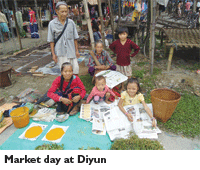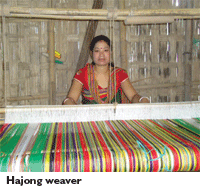On a two month sabbatical as a volunteer teacher in a local school in a remote corner of Arunachal Pradesh, Yoginder Sikand acquired fascinating anthropological insights into vanishing tribal cultures
 Located in the far eastern corner of Arunachal Pradesh, on the Changlang border near the trisection of India, Myanmar and Tibet, Diyun (pop. 29,000) is a large village and a major marketplace for tribal hamlets of the region. That is where I spent a two month sabbatical earlier this year as a volunteer teacher in a local school.
Located in the far eastern corner of Arunachal Pradesh, on the Changlang border near the trisection of India, Myanmar and Tibet, Diyun (pop. 29,000) is a large village and a major marketplace for tribal hamlets of the region. That is where I spent a two month sabbatical earlier this year as a volunteer teacher in a local school.
Diyun offers almost nothing of interest to the conventional tourist. Until recently, almost the entire area — stretching from the near border of Assam to the towering mountains of the Patkai Bum range in the eastern Himalayas which straddle the Myanmar border — was under dense forest cover. Human habitations consisted of a few families living in bamboo huts, engaging in fishing, hunting and jhum (shifting) cultivation.
Suddenly in the 1960s, this region experienced a total transformation after thousands of Chakma and Hajong refugees — tribals living in East Pakistan (now Bangladesh) — fled religious persecution and were settled here by the government of India. Today, the majority inhabitants of the Diyun Circle are Chakmas and Hajongs, mostly impov-erished small cultivators, fisher folk and craftsmen. In addition to them are small pockets of other, more powerful and prosperous tribes, notably Mishmis, Nagas, Mossangs, Singphos and Khamtis.
Because the Diyun Circle doesn’t have a long history, it is devoid of historical attractions which draw tourists. Several decades ago it was a vast nature reserve, replete with flora and fauna. Today, only small patches of forest dot the plain, and even on mountainous hillsides large stretches of forest have been indiscriminately felled to create arable land. Selling timber is lucrative business for some, while for others it’s a means of sheer survival.
Rampant deforestation around Diyun (and, indeed, across Arunachal Pradesh, which was once among the most densely-forested states of India) has meant that wildlife is nearly extinct here. Elephants, bears, leopards and tigers were a common sight around Diyun, but with their natural habitat destroyed and prevalence of large-scale poaching, they are hard hit and it’s rare to spot even the state bird of Arunachal Pradesh — the hornbill. All I got to see were a couple of giant spiders, a bison, snake and the common white stork.
With sparse wildlife and no major monuments in the area, it’s hardly surprising that few visitors tarry at Diyun. But for the traveler with an anthropological interest in tribes and tribal culture, Diyun — and several other parts of Arunachal Pradesh — is fascinating terrain.
Almost every afternoon, during my two-month sojourn in Diyun, I would walk or cycle through hamlets to witness a way of life that is fast disappearing in the relentless march towards modernisation. It’s no cakewalk traversing the slushy pathways, streams and jungle tracks of the Diyun Circle or most of Arunachal. But that’s the only way to do it. There are hardly any paved roads in the state and only the occa-sional bus connects a few hamlets. Automotive vehicles are almost unkn-own, so the only sounds one is likely to hear is of the wind whistling through clumps of bamboo, of birds chirping in the trees and frogs croaking in marshy ponds, and of village children playing in the fields.
I spent many hours after school sessions in and around Diyun, paddling through brooks, watching men smoke pipes made of long shafts of bamboo, women working paddy fields and ducks floating in quaint pools. Often I hiked to the banks of the enormous Dihing river to behold a glorious sunset and watch tribal folk lay ingenious fish traps made of bamboo poles or hunt for insects under boulders on river banks.
Local communities still maintain their traditional lifestyles and it’s fascinating to watch village youth assemble a hut, with just a couple of bamboo sticks for a frame, straw mats for the walls, wooden poles for stilts, dried leaves for the roof, and a log of wood with broad slits in the middle for stairs, in record time. Another enduring memory is of village elders weaving delicate cane containers for worship, baskets, cradles and hand-fans, and young women work-ing at their looms, weaving exquisite, brightly-hued sarongs and towels. I would sometimes join a group of women — it’s always women, particularly, elderly women — walking miles in search of a fish-laden stream, balancing huge cane fishing baskets on their heads. And a not-to-be-missed highlight is the bi-weekly street market, where tribals dressed in their Sunday best trade grains and vegetables, hand-woven dresses, and exotic fruits of the forest.
 Most of the ethnic groups inhabiting the Diyun Circle and its peripheries claim to be Buddhists. There’s certainly no shortage of friendly monks, many of whom are engaged in masterly inactivity, explained as meditation. Almost every village here has a Buddhist temple exhibiting Burmese pagoda-style influences. Temple monks differ from ‘forest monks’ who meditate in solitude in forests or what’s left of them. On every full-moon/new-moon day, villagers flock to the monasteries to listen to religious discourses. You may not understand a word, but it’s an experience not to be missed. Moreover, if you are lucky you might be able to witness a Kathin Chivar Dan Puja, when hundreds of women of the Chakma tribe gather in the Buddhist temples to weave robes for monks, as an act of piety.
Most of the ethnic groups inhabiting the Diyun Circle and its peripheries claim to be Buddhists. There’s certainly no shortage of friendly monks, many of whom are engaged in masterly inactivity, explained as meditation. Almost every village here has a Buddhist temple exhibiting Burmese pagoda-style influences. Temple monks differ from ‘forest monks’ who meditate in solitude in forests or what’s left of them. On every full-moon/new-moon day, villagers flock to the monasteries to listen to religious discourses. You may not understand a word, but it’s an experience not to be missed. Moreover, if you are lucky you might be able to witness a Kathin Chivar Dan Puja, when hundreds of women of the Chakma tribe gather in the Buddhist temples to weave robes for monks, as an act of piety.
Residents of the Diyun Circle are friendly people and it’s quite usual to be invited into homes for a meal or cup of tea, which could end up in hours of chat and give a glimpse into the lives of people living in one of the most isolated outposts of a state which itself is sited in a remote corner of India. The information I gathered was that the Chakmas and Hajongs, who constitute a majority in this area and are among the poorest communities of Arunachal, continue to suffer deep neglect, with hardly any villages touched by state-sponsored welfare or development programmes. Employment by the state government is scarce, and the little ‘development’ that’s visible has extra-cted the price of destruction of local traditions. Drug addiction and alcoho-lism are pervasive as is the deleterious impact of television, with banal Bollywood heroes replacing tribal elders as youth role models.
 After Diyun, I cycled 20 km to the neighbouring town of Miao, traversing an enormous river, which comes roaring down the Himalayas. There is no bridge here, so one has to walk half way on foot in knee-deep, emerald-blue water, and cover the remaining distance in a country boat. There isn’t much of interest in Miao, except for a small Tibetan refugee settlement. The town’s other attraction, a small zoo, is in a shambles — with its assortment of Himalayan bears, porcupines, snakes, slow lorises and monkeys trapped in miserable concrete prison-like enclo-sures, bereft of any greenery or mud. Nevertheless an excursion to Miao takes you through stretches of forest, through Chakma, Naga, and Singpho villages, and past little Buddhist temples, which are eye balm.
After Diyun, I cycled 20 km to the neighbouring town of Miao, traversing an enormous river, which comes roaring down the Himalayas. There is no bridge here, so one has to walk half way on foot in knee-deep, emerald-blue water, and cover the remaining distance in a country boat. There isn’t much of interest in Miao, except for a small Tibetan refugee settlement. The town’s other attraction, a small zoo, is in a shambles — with its assortment of Himalayan bears, porcupines, snakes, slow lorises and monkeys trapped in miserable concrete prison-like enclo-sures, bereft of any greenery or mud. Nevertheless an excursion to Miao takes you through stretches of forest, through Chakma, Naga, and Singpho villages, and past little Buddhist temples, which are eye balm.
The road to Miao branches off to Namdapha National Park. Spread over some 2,000 sq. km, the park is the largest protected area in the eastern Himalayas. Its topography ranges from sub-tropical evergreen forests to alpine meadows and perennial snow-capped peaks, and it still boasts varied wildlife.
Another option is a truck service to the Hindu pilgrimage centre of Parasuram Kund, near the Tibet border, beyond the town of Wakro, epicentre of the Mishmi tribe. The road cuts through green fields and forests, interspersed with orange plant-ations, till it reaches the mighty Brah-maputra, which cascades thunderously from the mountains.
As elsewhere in Arunachal Pradesh, the Diyun Circle is woefully lacking in facilities for tourists. Nor is this a safe habitat, especially after dark, with reports of extortion and kidnappings almost routine. And, there is the additional problem of underground rebel groups which are active in the area. But for those with a bit of daring, it prom-ises to be — as it was for me — a richly rewarding education experience.
Yoginder Sikand